
 |
A one minute digital video of the journey that produced Returning Wounded awaits you above. (QT 5.3 MB)
Painting’s attainment of a cultural vitality akin to that of Music is a dream of mine - like how we carry our MP3 soundtrack with us as a cultural norm, a natural preserve of identity, discussion and love. As an art delivery system, the web is a thing of beauty because, similarly, it can deliver art and its making to a person’s private realm, on demand.
In this spirit, I’m trying something new: Instead of presenting this latest process video solely on TINSQUO - as with Goya Moment - I’m cross-posting the video on that wild, democratic bazaar of human expression known as YouTube. Rate on!
When I embarked on the painting that would become Returning Wounded, I did so with no life experience of painting in the manner of a Northern European Renaissance master. I had no idea how or if I could do it. I figured though - if I never quit, I’ll never fail.
The common painting aphorism goes “paint what you see,” which - if it delivers the exclamation: “I didn’t see that coming” - seems to me like a good enough directive.
It turns out that my salvation, in this instance, would reside in technology - but not its application - just an observation: Click the magnifying glass icon from the photoshop tool bar and even the highest resolution image is revealed as consisting of discrete colors in prescribed areas - pixels in a grid. While painting, I often reoriented myself with this assuring reminder.
When complexity (or history) threaten to overwhelm, there can be utility in viewing painting reductively and simply putting the right color in the right place. That the protracted experience of clicking a mouse and staring at a computer monitor should facilitate old master painting techniques was one outcome I didn’t see coming.
While working on this canvas, my painting rhythm yielded a long walk home during hours when “The City That Never Sleeps” is at its most drowsy and my stride rode the wake of sanitation crews.
Freshly installed white plastic bags would be prepared, up and down each avenue, cinched atop the garbage baskets. Howling winds through the urban canyons occasionally treated me to hilarious inversions of these bags - setting them waving wildly above their rims, effectively reversing the order of interior versus exterior. I’d wonder just what am I looking at?
After months inside the process of creating Returning Wounded, my position has inverted to its dispassionate exterior. With the weathered directive “paint what you see” arriving at its corollary: “see what you paint,” now you and I meet in league, as viewers.
Details:
Process Video
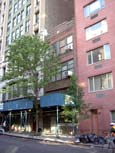 |
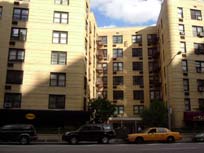 |
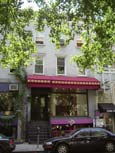 |
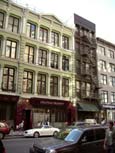 |
Giants walk among us and within us - in memory, in knowing. Those of us fortunate to walk the streets of New York City stroll amidst the hovels that sheltered such giants every day.
“...I have some feeling about all these people - million[s] of them - on this enormous track, way into history. They had a peculiar way of measuring. They seemed to measure with a length similar to their own height. For that reason, they could imagine themselves in almost any proportions.”
In his essay “The Renaissance And Order,” Willem de Kooning (1904-1997) famously described a particular historical through-line, what he called “a train track in the history of art that goes way back to Mesopotamia.”
The photographs above offer a present-day portal to key locations of New York City painting studios in the story of de Kooning and, by extension, the story of Art’s history.
Dreams of possibility abound behind every window, in the face of every passerby and in the persisting relics of those who trailblazed Art’s track from Mesopotamia to Gotham’s metropolis. De Kooning constructed his paintings of such glimpsed dreams - allowing previous incarnations, traces of discarded tangents and struggle to remain visible in his finished compositions. Much of his work’s lingering power derives from this honoring of each painting’s history and the history of the painter who painted it.
Right now on the streets of Lower Manhattan, in blocks that bear the address of de Kooning’s principle New York studios, you’ll find an installation (most days) displaying a temporary, unofficial art historic registry. Four placards (more locations as time permits) describe some of what transpired in the respective de Kooning address. Each poster is like an open window, beckoning passers-by into the process and works that emerged from de Kooning's studios.
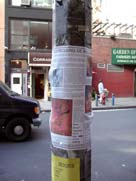 |
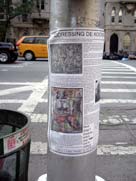 |
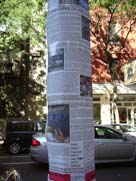 |
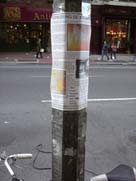 |
Below are PDFs of the posters.
143 W. 21nd Street
156 W. 22nd Street
85 4th Avenue
88 E. 10th Street
831 Broadway
The project is a way to concretize the profound, evanescent memories these coordinates possess. Think of it as public service graffiti - freshly installing the paintings of one giant into the world of daily experience from which they came so we, the People, can walk among them.
If you won’t be in NYC during the nuanced, crackling days of Fall, take your own virtual tour of the neighborhood with the PDFs above.
This project acknowledges and owes much to the excellent biography, de Kooning: An American Master by Mark Stevens and Annalyn Swan.
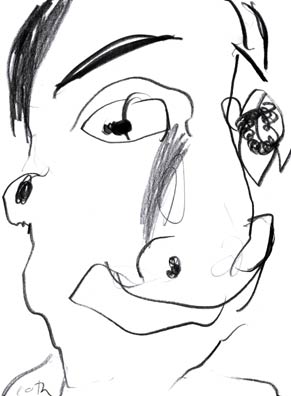
Today's NY Times has an article on biophilic design. Perhaps the logic of arousing biophilia culminates in the ultimate deconstructivist architecture - shelter and well-being through the elimination of barriers. Sheltering Nature purifies the air, relaxes the psyche and lets the spirit soar to the sky (or a simulacrum thereof).